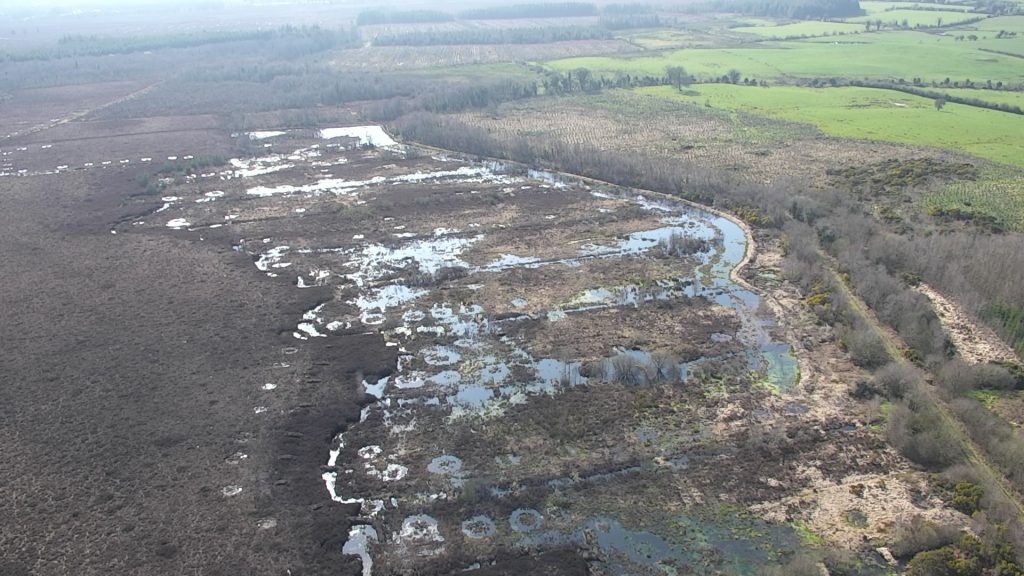Life Project on Ardagullion Bog
Ardagullion Bog is of considerable conservation value. We got to work here after extensive ground truthing of digital surveys in February 2018, returning to the site to complete the works between December 2018 and February 2019.
We installed 733 dams on the cutover and high bog, and also a 700m barrier dam along the western cutover – an impressive structure that saw an almost immediate return of rare flora and fauna.

Barrier Dam along Ardagullion Cutover. Pic: Declan Murray/Skyfab
The current conservation objective for Ardagullion Bog is to restore the area of Active Raised Bog to the area present when the Habitats Directive came into force in 1994. The objective also includes the restoration of Degraded Raised Bog and the restoration of the cutover areas will also play a major role.
The Area objective for Active Raised Bog is approximately 23.48ha (comprising 16.68ha on high bog and 6.80ha on cutover).
The objective in relation to Structure and Functions (S&Fs) is that at least half of the Active Raised Bog area should be made up of the central ecotope and active flush (i.e. the wetter vegetation communities). These values have been set as Favourable Reference Values.
Degraded Raised Bog still capable of regeneration should be capable of regeneration to active raised bog in 30 years if appropriate measures are put in place (i.e. no major impacting activities are present and any necessary restoration works are implemented).
In the past the habitat area was considered to be all high bog not considered to be active, but this is now not accepted as much of the high bog can no longer be restored to active (DAHG 2014). The remaining non-active high bog is considered supporting habitat for the Annex I habitats on the high bog. This supporting habitat is an essential part of the hydrological unit necessary to support Active and Degraded Raised Bog habitats.
The restoration of suitable cutover areas is essential for Active Raised Bog to achieve the favourable conservation condition at the site. Nevertheless, it is acknowledged that a long period of time (i.e. over 30 years) may be needed after appropriate restoration works are undertaken on the cutover areas for the habitat to develop.
Restoration works along the western cutover on one of our other project sites, Killyconny Bog SAC (on the Cavan/Meath border) indicated the occurrence of pioneer ‘active raised bog’ vegetation eight years after works were undertaken. Based on the close ecological relationship between Active Raised Bog, Degraded Raised Bog and Rhynchosporion depressions, it is considered that should favourable conservation condition for ‘Active Raised Bog’ be achieved on the site, then, as a consequence, favourable conservation condition for the other two habitats would also be achieved.
There are numerous drains associated with the face bank of this bog. Only one drain system cuts into the bog (in the east). These drains have an out-flow in the south-east and blocking this would re-wet the high bog. Our hydrology survey work is still being carried out on site.
PREVIOUS RESTORATION WORKS (LIFE04 NAT/IE/000121)
Restoration works, in the form of tree felling and drain blocking on the high bog and cutover took place (2004-08) under LIFE04 NAT/IE/000121on 25.00ha within the SAC. With the removal of conifers and blocking of drains, there was a rise in the water-table, which allowed for the colonisation of bog vegetation and Sphagnum mosses on the high bog areas. However, due to the dry marginal nature of the young plantations on cutover bog, scrub dominated by Downy Birch (Betula pubescens) is becoming established in these areas.
For more on this study, click here.

